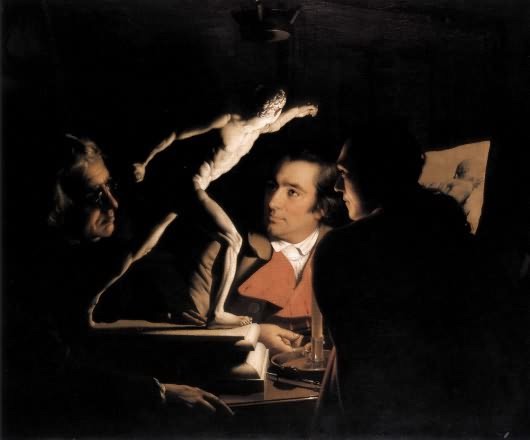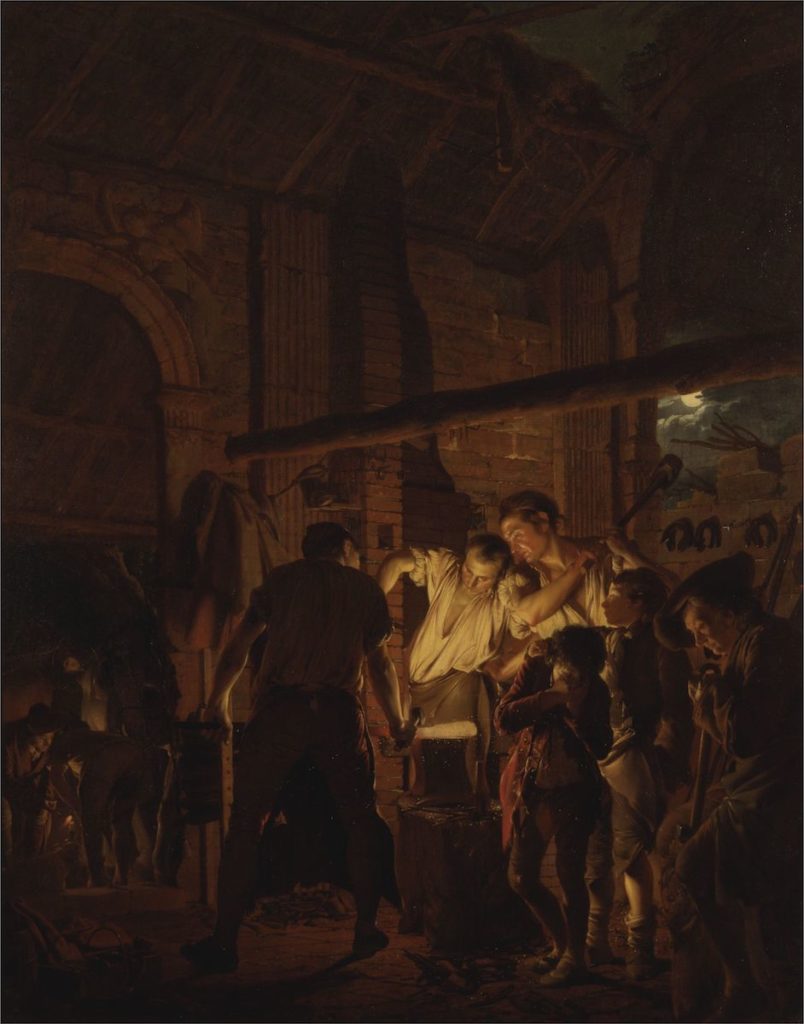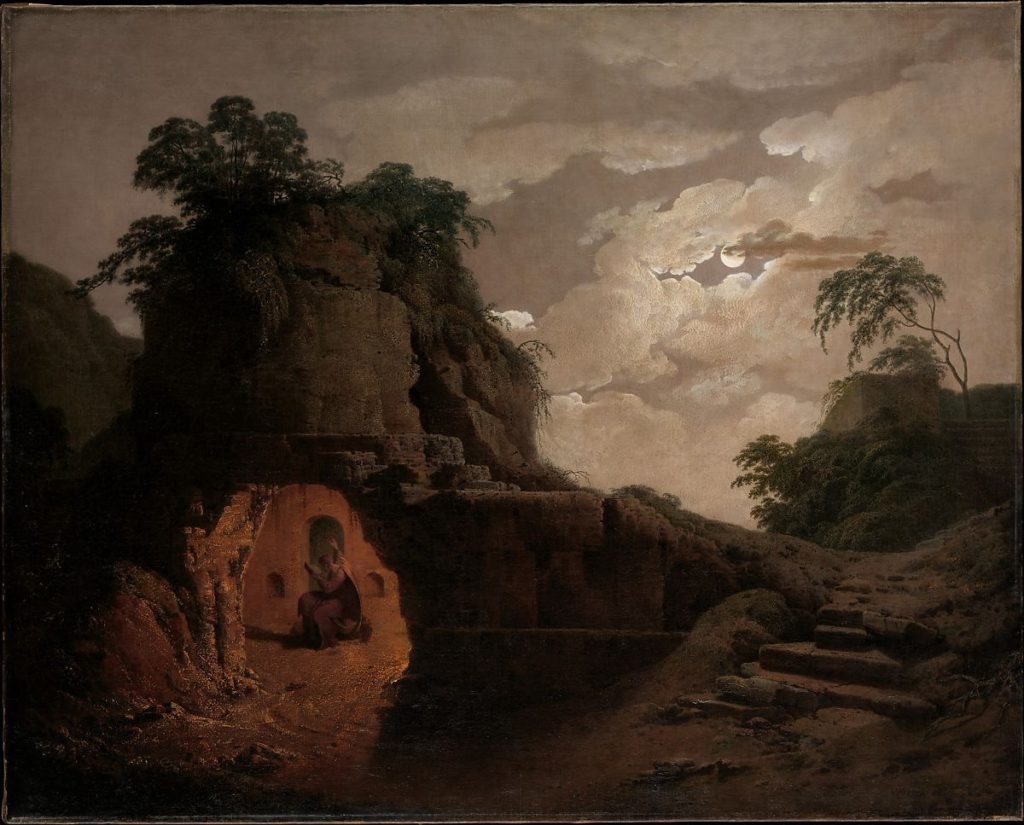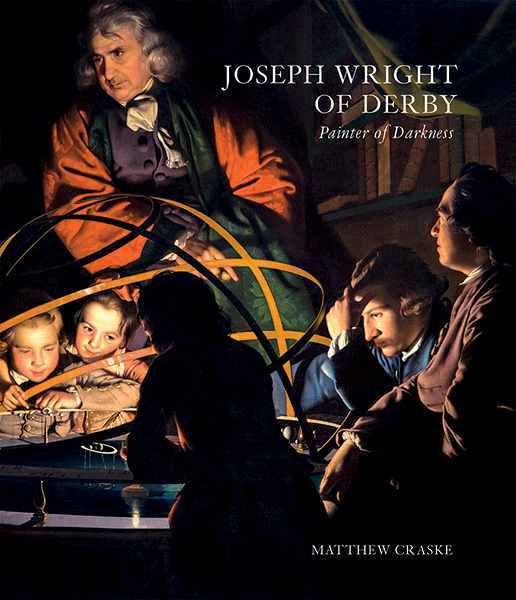Matthew Craske, Joseph Wright of Derby: Painter of Darkness (London: Paul Mellon Centre for Studies in British Art, 2020), 368 pages, ISBN: 978-1913107123.
Everything you think you know about Joseph Wright of Derby ( 1734–1797) and his paintings may be wrong. Or at least Matthew Craske’s meticulous new book will have you rethinking the most common interpretive frameworks that have been nearly universally accepted as the essential concerns and values to which the painter was committed. Take a number of routine claims made about An Experiment on the Bird in an Air Pump of 1768 (National Gallery, London): For notwithstanding common assertions to the contrary, the life of the cockatoo doesn’t actually hang in the balance. The demonstrator in charge of the experiment likely isn’t an itinerant showman. That’s not a skull in the vitrine on the table. The experiment doesn’t take place in town but in the countryside. It’s not a picture that opposes science to religion, nor is it about the imagined excesses of science. Indeed, it may say as much about its first owner, Dr. Benjamin Bates, as it does about Joseph Wright.[1]
More importantly—beyond just correcting particular misconceptions about well-known paintings—Craske asks us to consider the enormous scholarly imbalance that has embraced the Air Pump, alongside a handful of other pictures, but has had little to say about The Old Man and Death of 1773, or Edwin from Beattie’s Minstrel from 1777–1778, or the Italian landscapes from the 1780s, or the Small Prison Scene from the late 1780s, or any number of other paintings at odds with conceptions of Wright as an exemplar of Enlightenment sociability and optimism.[2] In place of these familiar narratives—first advanced by Benedict Nicolson’s 1968 book Joseph Wright of Derby: Painter of Light—in which Wright’s art was understood as a visualization of “science,” industrial commerce, progress, indeed revolution (and all that fraught word could mean in the late 1960s), Craske asks us to look for Wright in the shadows.[3] In place of an Enlightenment grounded in a commercial polity, upward social mobility, and secular materialism, Craske stresses vastly different contexts for seeing Wright’s paintings: literary loneliness, melancholic gloom, delicate sentimentalism. Particularly compelling is how Craske employs primary sources and biography, of the most engaging and productive sorts, to make his argument. Craske’s book isn’t simply a different interpretation of Wright; instead, it offers an entirely different strategy for understanding Wright’s life and work, an approach firmly grounded in eighteenth-century ways of thinking and feeling and looking, and in Wright’s particular experience as an artist.
For me, the book succeeds in three key areas. Repeatedly, over the course of thirteen chapters, Craske builds a coherent narrative that recasts Wright not as a clear-eyed prophet of modernity but as a painter grappling with conflicting instincts and often arriving at his most “contemporary” gestures in dialogue with well-established traditions, both artistic and social. Second, the book offers an extraordinary model for how one might write the story of an artist’s life and career. Having heard assured pronouncements of the death of the single-artist monograph since I was a graduate student in the late 1990s, I realize this claim likely sounds audacious, even absurd (the monograph surely does face high hurdles, and the genre too easily devolves into something no one particularly wants to read). But structurally and methodologically, this book feels fresh.[4] I attribute that achievement to a third success: what finally emerges is not simply a new understanding of Wright but a new sense of how he interacted with and was shaped by his world. In short, this is a book for better understanding eighteenth-century Europe, not just one painter from Derby. In the preface, Craske says as much explicitly: “this, for me, has been an exercise in creating a new way of writing about eighteenth-century art which happens to have its main subject in Wright” (viii). Revisiting the opening pages after finishing the book, I think that I now understand the weight of the claim. It’s not just wishful thinking on Craske’s part, but candid self-reflection and not a bad summation of why this book matters well beyond offering better interpretations of a handful of iconic paintings.

After an introduction, part one of the book comprises four chapters addressing key themes: 1) Wright’s identification with his hometown of Derby; 2) Wright as a painter of nocturnal pictures who excelled at visualizing light in dark settings; 3) Wright as an independent outsider (a sensibility grounded in his biography and personality, but one also embraced for commercial reasons and viewed in opposition to London’s art establishment, particularly the Royal Academy); and finally 4) Wright as a man of feeling best understood within the eighteenth-century discourse of sentiment and moral tenderness (as stressed by the earliest biographies from 1797, written just after his death, though largely discounted by twentieth-century scholars). The remainder of the book, part two, is made up of nine chapters, each focused on a particular painting or a series of closely related paintings:
• Three Men Viewing the Gladiator (1765; Fig. 1) and Orrery (1766)
• Air Pump (1768)
• Old Men (1769–1779)
• Laborers (1770–1772)
• Miravan Breaking Open the Tomb of His Ancestors (1772)
• Virgil’s Tomb (1770–1795; Fig. 3)
• Edwin from Beattie’s Minstrel (1777–1778)
• The Indian Widow (1785)
• The Dead Soldier (1789)
With these case studies taking up two-thirds of the book, the themes from part one are unpacked and developed with sustained, close analysis of production contexts, networks of advisors and patrons and buyers, exhibition histories, and surrounding documentation. Thus, while Craske’s is a model of life writing in the Vasarian tradition, the structure of the book is thematic rather than rigidly chronological. And yet themes and biography work together, with enormous coherence as the payoff. For both personal and aesthetic reasons, paintings make sense as part of a larger œuvre.
Although Craske is adamant that we expand our conception of Wright to include a range of paintings beyond the Orrery and Air Pump, he is still nonetheless an engaging and expert guide for these early works, too. Part of his success—and, indeed, a glimpse of how he builds arguments throughout the book—depends upon starting with Three Men Viewing the Gladiator by Candlelight (1765; Fig. 1). Playing to his book’s title, Craske judges that all three paintings depend upon “the broader understanding, dear to authors of night-thoughts poetry, that the night was an occasion when the mind became susceptible to the contemplation of profound, and profoundly important, matters” (89). He also describes all three pictures, in keeping with their eighteenth-century reception, as “variants of group portraiture.” In the case of the Three Men Viewing the Gladiator, Wright includes himself (in profile to the right) alongside his friend Peter Burdett, a land surveyor and cartographer (in the middle), and possibly “Old John Wilson of the Devonshire Alms Houses” (to the left, as identified by William Bemrose, an early biographer).[5] Thus, there may be something of a joke about the painting in that Old John is the one to offer drawing lessons. Craske is especially effective in bringing the picture alive:
Wright cleverly evoked a sense of the time in which ‘the conversation’ between the three characters has taken place. We can guess that the figure of the draughtsman, Wright himself, has just moved from the chair in which Old John is now sitting. Alternatively, the white-haired man has just swiveled the statue so that he could see it from the draughtsman’s angle. Old John stoops so that his eye level is exactly the same as that from which the drawing has been made. A porte-crayon has been laid on the table, next to the candle, to make it clear that the process of drawing has just finished. The inference that we draw is clear: in this picture Wright is about to get a learned critique of his drawing from Old John (96–97).
And yet, if there is humor intended, Wright is also entirely sincere and even affectionate. The chapter unpacks the trope of the aged artist instructing youth (perhaps borrowed from a 1531 print by Agostino Veneziano) as an evocation of the wisdom of the “ancients” more broadly. Craske also connects the figure of Old John in the painting to mezzotint character heads from the early 1760s by the Dublin-born painter Thomas Frye, known to Wright through Frye’s business partner, William Pether, a mezzotint scraper.

As Craske would have it, we misunderstand Wright and most of his future paintings if we too casually dismiss this aged figure in the Gladiator picture. In referencing the discourse of antiquity, Old John also supplies the narrative momentum of the painting, establishing a mood, a way of looking and feeling. Similarly contemplative figures will appear in the Orrery and the Air Pump. Similarly contemplative figures will—and this is the crucial point—also appear in The Hermit of 1769 (Derby Museum and Art Gallery), The Blacksmith’s Shop of 1770 (Yale Center for British Art; Fig. 2), an Old Beggar Man of 1771 (private collection), The Alchymist of 1771 (Derby Museum and Art Gallery), and A Philosopher by Lamplight of 1779 (private collection). Two versions of The Captive from Sterne from 1774 (Vancouver Art Gallery) and 1775–1777 (Derby Museum and Art Gallery) carry the theme explicitly into the realm of literature. There are clear connections, in other words, throughout Wright’s oeuvre (with the aged man being just one example). The connections just aren’t the ones articulated by most of Wright’s commentators for the past fifty years.

Craske observes that “there is no primary evidence that Wright played a part in, or was privy to, the scientific meetings of the Lunar Society,” nor any “indications that Wright took part in the meetings of the Derby Philosophical Society” (114). And in any case, those organizations emerged in the 1770s and 1780s rather than the 1760s, when Wright’s “science” paintings were made. Likewise, rather than finding in the forge paintings “the first stirrings of revolutionary socialism in a proto-industrial society,” Craske emphasizes their connections to Salvator Rosa and stoic philosophy, arguing that the “social humility that Wright sought to inculcate was…born of a conservative understanding…that the nation was a sympathetic community, with each class taking its allotted part… The pictures of iron work found ready buyers, largely from the aristocracy and landed gentry…These were images of a society that, for all it was lowly, was agreeable to some elevated observers as a form of reassurance, suggesting that the poor [as depicted in these paintings] were content and worthy of respect as long as they kept, in a picturesque manner, to their humble roles” (187).
Again and again, Craske offers readings of Wright that situate him within traditional, albeit newly revived, frameworks, while stressing that the painter was responding in thoughtful and intentional ways to the world around him, including ways in which life was changing (Wedgwood persists as an important part of the story). The book’s argument works not to remove Wright from the eighteenth century but just the opposite: to locate the painter more credibly in his own place and time. That project touches on numerous subjects that should be of interest for people who may not think they’re necessarily interested in a monograph on Wright: topics including London’s art institutions (especially the Royal Academy but also the rival Society of Artists); the commercial art world generally, including single artist exhibitions; dynamics tied to patrons of art vs. consumers of art; Anglo-Dutch artistic relationships; relationships between London and other urban centers as well as more remote areas of England; Italy and the Grand Tour; melancholia and the sublime; literary sources for paintings; and discourses of feeling and sentimentalism.
In closing, I would return to the topic of “science” and suggest one additional implication of the book. For all the ways in which Craske successfully calls into question modernist understandings of Wright as an exemplar of Enlightenment optimism and radical change, he also provides resources for revisiting overly simplistic views of what eighteenth-century engagements with the natural world consisted of in the first place. One foundational problem of the interpretation of Wright that has prevailed in the past half-century is that it tends to presume an institutional conception of science that was only gradually emerging in the late eighteenth century and really would not take firm shape until the nineteenth century. The original owner of the Gladiator painting, as with the air pump picture, was Dr. Bates, a student of the physician and anatomist William Hunter—who through his collections would help shape that fledgling institutional identity of science as something much larger than learned societies and associations.[6] In fact, Bates, according to Craske, likely commissioned the Gladiator picture, a modest purchase that then led to the more ambitious Air Pump painting. By stressing the role of such patrons and Wright’s social network more largely, Craske gives us new ways to think about the new ways of seeing that emerged in the eighteenth century. Well beyond the ‘science’ paintings that Craske insists belong in the very early portion of the artist’s career, Wright’s entire body of work continues to be emphatically about visual experience and observation—and at least in some cases for patrons and collectors who were interested in what we now call science. It’s just that those new ways of seeing did not necessarily entail the politically progressive agendas we’ve long been conditioned to expect. While the book leaves me entirely convinced that Wright was not the prophet of progressive politics that Nicolson understood him to be, this “painter of darkness” seems all the more relevant to wider conversations about what exactly empiricism entailed in the eighteenth century.
Craig Hanson is a Professor of Art History at Calvin University
[1] Or at least, what the painting says about Wright makes sense only in connection to Dr. Bates and the relationships that Wright cultivated with his supporters. Craske, in fact, believes the painting was likely commissioned by Bates. Noting the “highly unusual” subject, Craske suggests that it would have been “unlikely that Wright, as an emerging artist, would have risked making them [The Orrery and the Air Pump pictures] without a buyer in mind” (117). By contrast, David Solkin in Painting for Money: The Visual Arts and the Public Sphere in Eighteenth-Century England (New Haven and London: Yale University Press, 1993), 230, characterized the paintings as the works of an artist “acting independently of any patron” (quoted by Craske, 318n.4).
[2] As Craske writes in a note from the introduction, “To be concrete here, at least one hundred thousand words of secondary text might have been advanced in support of the case that Wright’s pictures of the orrery and the air pump have, in the past fifty years, been considered to define his place in the story of art and western civilization. One would be hard-pressed to cite a single claim that he was defined by, say, The Earthstopper or The Old Man and Death. Moreover, there is a significant absence of scholarship that is designed to make sense of the fact that the artist who made the first two of these pictures was also the author of the second two. . .” (302–03, n.11). I use the term “Enlightenment” here precisely because it was so central to the conceptual categories developed in the 1970s and 80s; I trust that it will be clear to readers of this review that just as Craske’s critique of this historiographical tradition is a central project of his book, it also implicitly contributes to important, ongoing conversations about the utility and failings of this contested term.
[3] Benedict Nicolson, Joseph Wright of Derby: Painter of Light, 2 vols. (London: Pantheon Books, 1968). Craske begins the introduction of his book by acknowledging Nicolson, whom he describes as “an accurate and astute cataloguer” (1). Engagement with the wider historiographic legacy is, for Craske, a key priority.
[4] Craske notes, “Though my book has a biographical character, I have decided to reject, from the outset, the kind of chronologically arranged ‘life’ narrative that has, over generations, proved to the most accessible form of art history” (5). Wright’s life is always front and center, but the book is not at all a biography; instead, themes and specific works of art provide the narrative thread. That said, one of the best brief lives of an artist I’ve ever read appears at the end of the introduction (5–7), the work of a scholar who clearly has embraced and digested the life of his subject.
[5] Burdett also appears in the Orrery and Air Pump paintings, wearing the striped waistcoat in each picture. Burdett was secretary for the man who first owned the Orrery: Vice Admiral Washington Shirley, 5th Earl Ferrers, a Fellow of the Royal Society and amateur astronomer. Craske suggests that Wright’s “interest in the apparatus of science was limited to the period of his friendship with Burdett, between 1763 and 1773, whose business was such technology” (114).
[6] Mungo Campbell, Nathan Flis, and María Dolores Sánchez-Jáuregui, eds., William Hunter and the Anatomy of the Modern Museum, exhib. cat. (New Haven: Yale Center for British Art, 2018).
Cite this note as: Craig Hanson, “Joseph Wright of Derby: A Review,” Journal18 (September 2021), https://www.journal18.org/5845.
Licence: CC BY-NC
Journal18 is published under a Creative Commons CC BY-NC International 4.0 license. Use of any content published in Journal18 must be for non-commercial purposes and appropriate credit must be given to the author of the content. Details for appropriate citation appear above.

